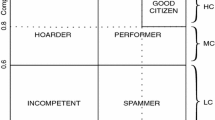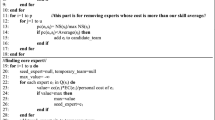Abstract
Much research has been done into the role of different team members through team problem-solving processes, though less research has been done into an optimal combination of members and the influence of their dominance on the team’s performance. Therefore, in this paper it is addressed what is the most effective combination of team members and whether dominance can increase team performance. For this purpose, an adaptive computational network model has been designed for a team problem-solving process. Different scenarios were simulated including a respectively homogeneous team and the representation of different dominant roles carried out by several team members. From these simulations, it can be concluded that heterogeneous teams perform better than homogeneous teams. Additionally, this study’s results showed that dominance can have both negative and positive effects on team performance.
Access this chapter
Tax calculation will be finalised at checkout
Purchases are for personal use only
Similar content being viewed by others
References
Appendix Linked Data at ResearchGate URL: https://www.researchgate.net/publication/348415599 (2021)
Aritzeta, A., Swailes, S., Senior, B.: Belbin’s team role model: development, validity and applications for team building. J. Manage. Stud. 44(1), 96–118 (2007)
Bales, R.F., Strodtbeck, F.L.: Phases in group problem-solving. Psychol. Sci. Public Interest 46(4), 485 (1951)
Bantel, K.A., Jackson, S.E.: Top management and innovations in banking: does the composition of the top team make a difference? Strategic Manag. J. 10(S1), 107–124 (1989)
Basadur, M., Head, M.: Team performance and satisfaction: a link to cognitive style within a process framework. J. Creative Behav. 35(4), 227–248 (2001)
Belbin, R.M.: Management Teams: Why They Succeed or Fail. Heinemann, London (1981)
Belbin, R.M.: Team Roles at Work. Buccerworth-Heineman, Oxford (1993)
Bell, M.A.: Phases in group problem-solving. Small Group Behav. 13(4), 475–495 (1982)
Boase, J., Wellman, B.: Personal relationships: on and off the Internet. Cambridge Handb. Personal Relation. 8, 709–723 (2006)
Carlson, M.P., Bloom, I.: The cyclic nature of problem solving: an emergent multidimensional problem-solving framework. Educ. Stud. Math. 58(1), 45–75 (2005)
Carron, A.V., Colman, M.M., Wheeler, J., Stevens, D.: Cohesion and performance in sport: a meta-analysis. J. Sport Exerc. Psychol. 24, 168–188 (2002)
Delbecq, A.L., Van de Ven, A.H.: A group process model for problem identification and program planning. J. Appl. Behav. Sci. 7(4), 466–492 (1971)
Dowell, N.M., Lin, Y., Godfrey, A., Brooks, C.: Exploring the relationship between emergent sociocognitive roles, collaborative problem-solving skills, and outcomes: a group communication analysis. J. Learn. Anal. 7(1), 38–57 (2020)
Dunbar, R.I.M., Arnaboldi, V., Conti, M., Passarella, A.: The structure of online social networks mirrors those in the offline world. Soc. Netw. 43(2015), 39–47 (2015)
Fiore, S.M., Smith-Jentsch, K.A., Salas, E., Warner, N., Letsky, M.: Towards an understanding of macrocognition in teams: developing and defining complex collaborative processes and products. Theor. Issues Ergon. Sci. 11(4), 250–271 (2010)
Georgiadis, G.: Projects and team dynamics. Rev. Econ. Stud. 82(1), 187–218 (2015)
Griffin, M.A., Neal, A., Parker, S.K.: A new model of work role performance: positive behavior in uncertain and interdependent contexts. Acad. Manag. J. 50(2), 327–347 (2007)
Hambrick, D.C., Cho, T.S., Chen, M.J.: The influence of top management team heterogeneity on firms’ competitive moves. Admin. Sci. Quart. 41(4), 659–684 (1996)
Heuzé, J.P., Sarrazin, P., Masiero, M., Raimbault, N., Thomas, J.P.: The relationships of perceived motivational climate to cohesion and collective efficacy in elite female teams. J. Appl. Sport Psychol. 18, 201–218 (2006)
Hoffman, L.R., Maier, N.R.F.: Quality and acceptance of problem solutions by members of homogeneous and heterogeneous groups. J. Abnormal Soc. Psych. 62(2), 401–407 (1961)
Hong, L., Page, S.E.: Groups of diverse problem solvers can outperform groups of high-ability problem solvers. Proc. Natl. Acad. Sci. USA 101(46), 16385–16389 (2004)
Humphrey, S.E., Morgeson, F.P., Mannor, M.J.: Developing a theory of the strategic core of teams: a role composition model of team performance. J. Appl. Psychol. 94(1), 48 (2009)
Kadushin, C.: Understanding Social Networks: Theories, Concepts, and Findings. Oup USA (2012)
Lehmann-Willenbrock, N., Beck, S.J., Kauffeld, S.: Emergent team roles in organizational meetings: identifying communication patterns via cluster analysis. Commun. Stud. 67, 37–57 (2016)
Mao, A., Mason, W., Suri, S., Watts, D.J.: An experimental study of team size and performance on a complex task. PLoS ONE 11(4), e0153048 (2016)
Mason, C.M.: Exploring the processes underlying within-group homogeneity. Small Group Res. 37(3), 233–270 (2006)
Meinecke, A.L., Lehmann-Willenbrock, N.: Social dynamics at work: Meetings as gateway. The Cambridge Handbook of Meeting Science, vol. 325, no. 356, p. 15. Cambridge University Press, New York, NY (2015)
Michaelsen, L.K., Sweet, M., Parmelee, D.X. (Eds.): Team-Based Learning: Small Group Learning’s Next Big Step: New Directions for Teaching and Learning, Number 116, vol. 103. John Wiley & Sons (2011)
Moon, H., et al.: Asymmetric adaptability: dynamic team structures as one-way streets. Acad. Manag. J. 47, 681–695 (2004)
Plsek, P.: Institute of Medicine. Crossing the Quality Chasm: A New Health System for the Century. National Academies Pr, Washington, DC (2001)
Prichard, J., Stanton, N.: Testing Belbin’s team role theory of effective groups. J. Manag. Dev. 18(8), 652–665 (1999). https://doi.org/10.1108/02621719910371164
Senior, B.: Team roles and team performance: is there ‘really’ a link? J. Occup. Organ. Psychol. 70(3), 241–258 (1997)
Smith, E.B., Hou, Y.: Redundant heterogeneity and group performance. Organ. Sci. 26(1), 37–51 (2015)
Tost, L.P., Gino, F., Larrick, R.P.: When power makes others speechless: the negative impact of leader power on team performance. Acad. Manag. J. 56(5), 1465–1486 (2013)
Treur, J.: Network-Oriented Modeling for Adaptive Networks: Designing Higher-Order Biological, Mental and Social Network Models. Springer Nature, Cham (2020)
Warner, S., Bowers, M.T., Dixon, M.A.: Team dynamics: a social network perspective. J. Sport Manag. 26(1), 53–66 (2012)
Wiltshire, T.J., Butner, J.E., Fiore, S.M.: Problem-solving phase transitions during team collaboration. Cogn. Sci. 42(1), 129–167 (2018)
Zaccaro, S.J., Rittman, A.L., Marks, M.A.: Team leadership. Leader. Q. 12(4), 451–483 (2001)
Author information
Authors and Affiliations
Corresponding author
Editor information
Editors and Affiliations
Rights and permissions
Copyright information
© 2021 Springer Nature Switzerland AG
About this paper
Cite this paper
Evegroen, S.A., Schoonderbeek, Y., Treur, J. (2021). The Effect of Emergent Team Roles on Team Performance: A Computational Network Model. In: Nguyen, N.T., Iliadis, L., Maglogiannis, I., Trawiński, B. (eds) Computational Collective Intelligence. ICCCI 2021. Lecture Notes in Computer Science(), vol 12876. Springer, Cham. https://doi.org/10.1007/978-3-030-88081-1_9
Download citation
DOI: https://doi.org/10.1007/978-3-030-88081-1_9
Published:
Publisher Name: Springer, Cham
Print ISBN: 978-3-030-88080-4
Online ISBN: 978-3-030-88081-1
eBook Packages: Computer ScienceComputer Science (R0)




